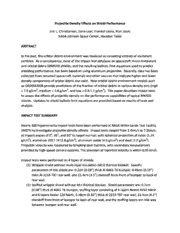
NASA Technical Reports Server (NTRS) 20090032052: Projectile Density Effects on Shield Performance PDF
Preview NASA Technical Reports Server (NTRS) 20090032052: Projectile Density Effects on Shield Performance
Projectile Density Effects on Shield Performance Eric L. Christiansen, Dana Lear, Frankel Lyons, Alan Davis NASA Johnson Space Center, Houston Texas ABSTRACT In the past, the orbital debris environment was modeled as consisting entirely of aluminum particles. As a consequence, most of the impact test database on spacecraft micro-meteoroid and orbital debris (MMOD) shields, and the resulting ballistic limit equations used to predict shielding performance, has been based on using aluminum projectiles. Recently, data has been collected from returned spacecraft materials and other sources that indicate higher and lower density components of orbital debris also exist. New orbital debris environment models such as ORDEM2008 provide predictions of the fraction of orbital debris in various density bins (high = 7.9 g/cm3, medium = 2.8 g/cm3, and low = 0.9-1.1 g/cm3). This paper describes impact tests to assess the effects of projectile density on the performance capabilities of typical MMOD shields. Updates to shield ballistic limit equations are provided based on results of tests and analysis. IMPACT TEST SUMMARY Nearly 100 hypervelocity impact tests have been performed at NASA White Sands Test Facility (WSTF) to investigate projectile density effects. Impact tests ranged from 2.4km/s to 7.2km/s; o o o at impact angles of 0 , 45 , and 60 to target normal; with spherical projectiles of nylon (1.14 g/cm3), aluminum 2017-T4 (2.8 g/cm3), aluminum oxide (4.0 g/cm3) and steel (7.9 g/cm3). Projectile velocity was measured by breaking laser barriers, with secondary measurement provided by high-speed camera systems. The precision of reported velocity is within 0.05 km/s. Impact tests were performed on 4 types of shields: (1)Whipple shield without multi-layer insulation (MLI) thermal blanket. Specific parameters of this shield are: 0.2cm (0.08”) thick Al 6061-T6 bumper, 0.48cm (0.19”) thick Al 2219-T87 rear wall, and 11.4cm (4.5”) standoff from front of bumper to back of rear wall. (2)Stuffed whipple shield without MLI thermal blanket. Shield parameters are: 0.2cm (0.08”) thick Al 6061-T6 bumper, stuffing layer consisting of 6 layers Nextel AF62 fabric and 6 layers Kevlar 120 fabric, 0.48cm (0.19”) thick Al 2219-T87 rear wall, 11.4cm (4.5”) standoff from front of bumper to back of rear wall, and the stuffing layers are mid-way between bumper and rear wall. (3)Whipple shield with one MLI thermal blanket. Shield parameters are: 0.1cm (0.04”) Al 6061-T6 bumper, 0.05 g/cm2 MLI attached to front-side of rear wall, 0.2cm (0.08”) Al 6061-T6 rear wall, and 5.1cm (2”) standoff from back of bumper to front of rear wall. (4)Whipple shield with two MLI thermal blankets. Shield parameters are: 0.05 g/cm2 MLI attached to front-side of bumper, 0.1cm (0.04”) Al 6061-T6 bumper, 0.05 g/cm 2 MLI attached to front-side of rear wall, 0.41cm (0.16”) Al 6061-T6 rear wall, and 1.7cm (0.67”) standoff from back of bumper to front of rear wall. A failure of the shield in the test is defined as any through penetration or through-crack in the rear wall, or detached spall from the back of the rear wall. TEST RESULTS Typical test results are shown in Figure 1 and 2, which show the whipple shield without MLI (target type 1) impacted by a 0.50cm diameter (0.50g) steel projectile and 0.63cm (0.54g) aluminum-oxide projectile at 6.8 km/s and normal (0°) impact angle. Both of these targets failed, although the damage from the steel projectile was greater. Results from some of the impact tests and analysis are summarized in the table below. This table shows the mass of the projectile of various densities that just fails the shield rear wall at the indicated velocity and angle. These results show that for both the Stuffed Whipple (type 2 shield) and whipple shield without MLI (type 1) the steel projectile is most penetrating (i.e., smallest mass penetrates) and the aluminum projectile is least penetrating (i.e., largest mass penetrates). Stuffed-Whipple shield (type 2) ballistic limits. Projectile Projectile Impact Impact Projectile diameter to mass to fail velocity angle Basis (test or analysis) type fail shield shield (g) (km/s) (deg) (cm) Steel 0.71 1.47 6.8 0 Test: HITF-5034 Al-oxide 1.03 2.29 6.9 0 Test: HITF-2229, 2095 Aluminum 1.35 3.61 6.8 0 Analysis: Ref.[1] Steel 0.87 2.67 6.8 45 Test: HITF-3028, 2087 Al-oxide 1.11 2.86 7.0 45 Test: HITF-2232, 3032 Aluminum 1.50 4.95 6.8 45 Analysis: Ref.[1] Steel 0.60 0.86 4.4 45 HITF-3030, 5232, 2228 Al-oxide 1.11 2.86 4.2 45 Test: HITF-2097, 2230 Aluminum 1.20 2.53 4.4 45 Analysis: Ref.[1] Whipple shield (type 1) ballistic limits. Projectile Projectile Impact Impact Projectile diameter to mass to fail velocity angle Basis (test or analysis) type fail shield shield (g) (km/s) (deg) (cm) Steel 0.32 0.13 6.7 0 Test: HITF-3033, 2156 Al-oxide 0.55 0.35 6.8 0 Test: HITF-2158, 2235 Aluminum 0.84 0.87 6.8 0 Analysis: Ref.[2] Steel 0.35 0.18 6.8 45 Test: HITF-2157, 2234 Al-oxide 0.56 0.37 6.7 45 Test: HITF-2236, 2082 Aluminum 0.69 0.48 6.8 45 Analysis: Ref.[2] Steel 0.35 0.18 4.6 45 Test: HITF-2081, 2100 Al-oxide 0.75 0.90 4.4 45 Test: HITF-5035 Aluminum 0.56 0.26 4.5 45 Analysis: Ref.[2] References 1. E.L. Christiansen, J.L. Crews, J.E. Williamsen, J.H. Robinson, A.M. Nolen, Enhanced Meteoroid and Orbital Debris Shielding, Int. J. Impact Engng, 17, pp.217-228, 1995. 2. E.L. Christiansen, Design and Performance Equations for Advanced Meteoroid and Debris Shields, Int. J. Impact Engng, 14, pp.145-156, 1993. Figure 1. Whipple shield (no MLI) rear wall damage caused by 0.50cm (0.5g) steel spherical projectile, 6.78km/s, 0° impact angle (test HITF-2098). Rear wall failed by detached spall and through-hole. Figure 2. Whipple shield (no MLI) rear wall damage caused by 0.635cm (0.54g) aluminum-oxide spherical projectile, 6.80km/s, 0° impact angle (test HITF-2101). Rear wall failed by detached spall (no through-hole).
